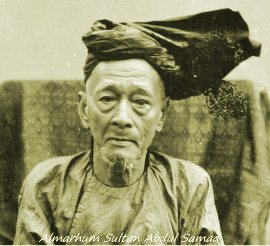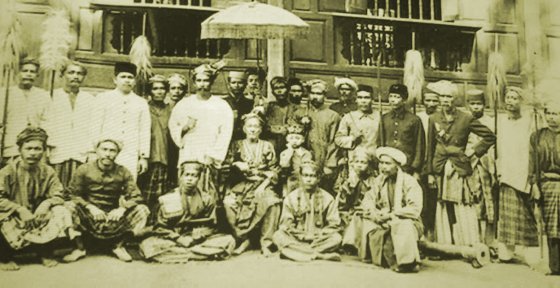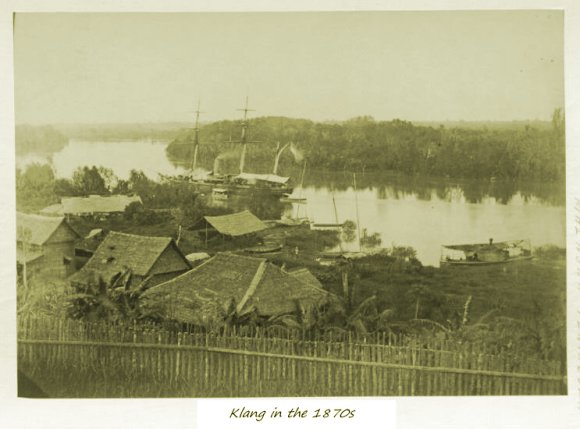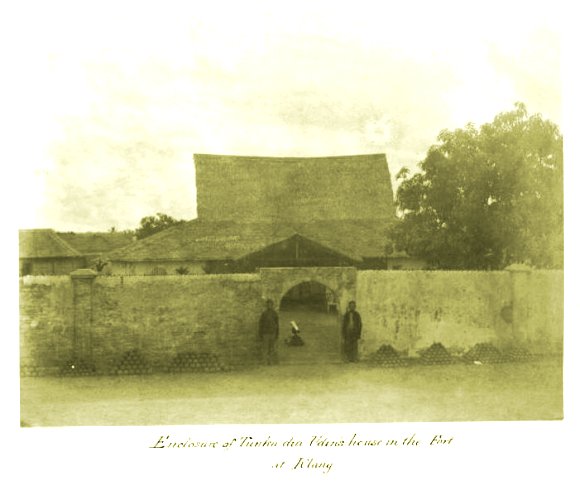|
|
The Battle for Klang
 With the death of Sultan Ibrahim
in 1826, Selangor fell on evil days - Sultan Muhammad, the next ruler,
was unable to control his chiefs. Between intervals of comparative
quiet, said Swettenham, in his book 'British Malaya', the "normal state
of Selangor was robbery, battle and murder". When Sultan Muhammad died
in 1857, there was a disputed succession, and Abdul Samad, who
eventually became Sultan, had all but given up the struggle to maintain
order. With the death of Sultan Ibrahim
in 1826, Selangor fell on evil days - Sultan Muhammad, the next ruler,
was unable to control his chiefs. Between intervals of comparative
quiet, said Swettenham, in his book 'British Malaya', the "normal state
of Selangor was robbery, battle and murder". When Sultan Muhammad died
in 1857, there was a disputed succession, and Abdul Samad, who
eventually became Sultan, had all but given up the struggle to maintain
order.
A key factor in the outbreak of the Selangor civil war was the feudal
system where the Sultan granted parts of the State, usually river
valleys, to kinsmen and nobles to be ruled by them. The key chiefdoms
were the valleys of the Selangor river, the Klang river, Lukut and
Bernam - the Sultan himself held the Langat river valley. The grant was
limited to the life of the holder and on their death, this frequently
resulted in their kinsmen or even other chiefs fighting over the
chiefdom. The landless nobleman was also often tempted to raise an
army, oust a weak rival and then negotiate with the Sultan for
recognition of his conquest.
A key economic factor in the Selangor Civil War was the growth of the
tin mining industry. For several centuries, the wealth of Selangor had
lain in its exports of tin. However, output from these mines was low.
This all changed when, in 1857 Raja Abdullah bin Raja Jaafar, the
ruling chief at Klang, introduced Chinese miners into what was to
become the Kuala Lumpur tin-field. By 1871 there were 12,000 Chinese in
Selangor. The recruitment of Chinese tin-miners by many of the Malay
chiefs had brought new and more efficient techniques, a large labour
force and vastly increased production . The now vastly increased
revenues of the tin trade became a bone of contention between the Malay
chiefs and the various clans of Chinese miners also quarrelled over
control of the tin-fields.
<> 
<> Sultan Abdul Samad
(seated on the chair in the centre) and his retinue.
<> Another factor that led to the outbreak of the Civil War was
the discontent that had been simmering over decades between the Bugis
rulers of Selangor and the Malays of Sumatran descent, such as the
orang Rawa, Mandailing and Minangkabau, whose ancestors had bitterly
fought the Bugis during the long wars of the 18th century. Raja
Abdullah, like the Sultan and the other chiefs, was a Bugis and his men
occupied the coast and most of the estuary as far as his headquarters
at Klang. Beyond this point the river was controlled by Sumatran Malays
under their headman the Dato Dagang. The Sumatran Malays made a living
as merchants in the interior or by transporting goods up and down the
river and they bitterly resented the import and export duties levied on
them by their Bugis rulers.
This discontent had been made worse when the Sultan canceled a
betrothal of marriage between his only daughter, 'Arfah, with Raja
Mahadi and instead married her off to the younger brother of the Sultan
of Kedah, Tunku Zia'u'd-din, usually known as Tunku Kudin (seated left
in the picture). The Sultan also made Tunku Kudin his Viceroy and Tunku
Kudin had with him a force of 500 Kedah Malays and an army of Bugis,
Arab and European mercenaries to impose his will. The presence of this
Kedah interloper and his army of 'foreigners' caused great resentment
among many of the Selangor chiefs.
In 1866, fighting broke out between the armies of Raja Abdullah and
Raja Mahadi for control of Klang, beginning almost ten years of
warfare. It started with a quarrel between a Bugis and a Sumatran
Malay, which resulted in the Sumatran being murdered. As was the
custom, the Dato' Dagang demanded blood money as compensation from Raja
Abdullah. Raja Abdullah did nothing to settle the grievance and the
Dato' Dagang appealed to Raja Mahadi for assistance. Raja Mahadi used
this a pretence to attack Klang with 200 of his men, using junks that
converged on the town from both directions, upstream and
downstream.Raja Mahadi occupied the fort on the hill overlooking Klang
and Raja 'Abdullah fled to Malacca as soon the fighting began, leaving
his son Isma'il to continue the battle. Some time later, Raja Abdullah
returned and attempted to re-take Klang, having borrowed enough money
from Chinese merchants to èquip an expedition. He had fitted out
two ships as war vessels, with cannon and sailed up the river, taking
position just below the fort.

Raja Abdullah's attack on Raja Mahdi failed miserably as he
was unable to elevate the guns in his war boats sufficiently high
enough to bombard Raja Mahadi's fort and the shots fell short, either
landing in the river or on the river bank. Raja Abdullah withdrew his
forces and left with his relatives and followers for Malacca, and
subsequently, Singapore. The fighting had lasted for about five months
and Raja Mahadi had attained his ambition of making himself the ruler
of Klang. But the matter was by no means closed.
Raja Abdullah's son, Raja Ismail, gathered another force to re-take
Klang, consisting of about 100 Ilanuns from Riau, kinsmen from Lukut
and Bugis mercenaries. In August, 1869, he reached the estuary of the
Klang River under cover of darkness and attacked the first of Raja
Mahdi's forts at Kuala Klang. The attack was a complete surprise -
though the fort was occupied by 30 of Raja Mahdi's men, none of its
guns were manned and no one was on watch. Some of the defenders were
killed but most fled back to Klang, bringing news of the defeat.
Ismail's force suffered one casualty - a man slashed by his own brother
who mistook him for an enemy as he wriggled through a gun embrasure to
get inside the fort.
Raja Ismail then proceeded to Klang. However, he only had 100 men,
which was not sufficient to overpower Raja Mahadi's fort in Klang and
he appealed to Tunku Kudin for assistance. Tunku Kudin and 500 Kedah
Malays joined the attack. The two forces now settled down for a long
siege, with Raja Mahdi's forces entrenched in the fort on the hill and
Tunku Kudin's forces camped in the fortified stockade that had been
build around Gedung Raja Abdullah just half a kilometre below. Both
sides dug in their fortified defences, content only to bombard each
other's positions with their cannon or use their muskets to snipe at
exposed enemy soldiers. Tunku Kudin only occasionally launched sorties
against the fort's ramparts, using his Bugis mercenaries - more to
harry and worry its defenders than to overwhelm them.

Tunku Kudin was a determined, single-minded man with a deep
perseverance that
none of his rivals possessed - rather than risk a failed frontal
assault, his army just sat down before Raja Mahadi's fort, blockading
the river so efficiently that neither food nor tin entered the town. He
did not attempt to carry it by assault but simply threatened it and
worried it for eighteen weary months, starving it of supplies and
ruining its trade with the interior. The theatrical valour of Raja
Mahadi was no match for Tunku Kudin's persistence - Raja Mahadi's
storehouses lay empty, his money ran out and his followers began
deserting him. In March 1870, Raja Mahdi was forced to abandon Klang
and retreated to Kuala Selangor.
At Kuala Selangor, we now meet another towering figure in the Selangor
Civil War - Syed Mashhor bin Syed Muhammad Ash-Sahab, known as Che Soho
to his Chinese allies. Syed Mashhor (centre in long head dress) was
from Pontianak in Borneo, a Malay of Arab descent and already known as
a fearless fighter. Early in 1870, he had been sent by Tunku Kudin to
take charge of the fort at Kuala Selangor. However, shortly after he
arrived, he recieved news that his brother had been killed at Langat by
Raja Yaakob - a son of the Sultan and Tunku Kudin's brother-in-law. He
vowed vengeance and from that moment on became a sworn enemy of the
Sultan and his Viceroy Tunku Kudin, abandoning the fort to Raja Mahadi
and joining with him in his war against Tunku Kudin in the years to
come.
For more images, see www.facebook.com/media/set/?set=a.10154808032077988
Write to the author: sabrizain@malaya.org.uk
The
Sejarah Melayu
website is
maintained solely by myself and does not receive any funding
support from any governmental, academic, corporate or other
organizations. If you have found the Sejarah Melayu website useful, any
financial contribution you can make, no matter how small, will be
deeply appreciated and assist greatly in the continued maintenance of
this site.
|
|


